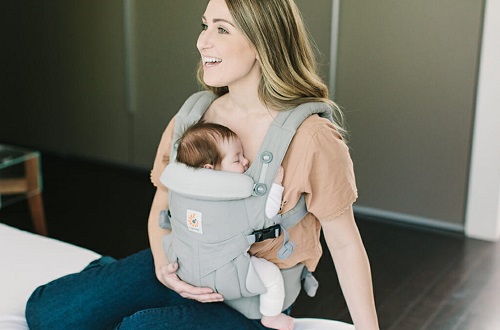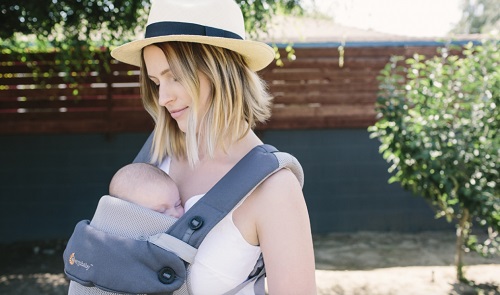The Ergo Baby Carrier offers a convenient and hands-free way to bond with your baby while allowing you to move freely. This guide provides everything new parents need to know about how to use Ergo Baby Carrier, from setup and safety tips to position options and common mistakes to avoid. Babywearing can be an enjoyable experience that supports your baby’s physical and emotional development. By using the Ergo Baby Carrier, parents can feel confident that their baby is supported in an ergonomic position that protects their growing hips and spine. Additionally, the carrier’s adjustable design makes it suitable for a wide range of body types and growing babies. Whether you’re preparing for your first outing or just need to keep your baby close at home, this step-by-step guide will ensure you feel secure and comfortable while using the Ergo Baby Carrier.

Why Choose an Ergo Baby Carrier?
The Ergo Baby Carrier has earned its place as a trusted choice among parents due to its focus on ergonomic support, comfort, and durability. Designed to evenly distribute your baby’s weight across your hips and shoulders, it helps reduce strain on your back and shoulders, which is essential for long periods of babywearing. The carrier’s design also prioritizes your baby’s health, keeping them in the ideal “M” shape, which promotes healthy hip development. With various carrying options, it’s flexible enough to grow with your baby from infancy through toddlerhood. Made from high-quality, breathable materials, it’s ideal for different climates and daily use. The Ergo Baby Carrier also includes features like an adjustable hood for privacy, sun protection, and easy breastfeeding on the go, making it an invaluable tool for busy parents seeking comfort and convenience.
How to Use Ergo Baby Carrier: Step-by-Step Guide
Using the Ergo Baby Carrier for the first time may feel daunting, but following a structured approach can make it simple and secure. Each step ensures a comfortable, safe experience for you and your baby.
Step 1: Preparing Your Ergo Baby Carrier for First Use
Before using the carrier, take a moment to inspect and set it up for initial use. Unbox all parts and familiarize yourself with the waist belt, shoulder straps, safety buckles, and any additional accessories like the infant insert. Adjust the straps to a loose base setting that will make it easy to tighten them once the carrier is on. Ensure all buckles and clips are in good condition, with no signs of wear or damage. Test the buckles with a gentle tug to verify they are secure. Position the waist belt around your hips, adjust it to a snug fit, and familiarize yourself with the buckle mechanics. Understanding how each component works is essential for ease of use and safety, giving you the confidence needed for secure babywearing.
Step 2: Securing the Waist Belt and Adjusting Shoulder Straps
Start by wrapping the waist belt around your waist, positioning it slightly above your hips to distribute the baby’s weight effectively. Fasten the waist buckle securely, ensuring it clicks in place, and adjust the belt for a snug fit, as this will be the primary support point. Slide the shoulder straps over each shoulder without twisting them, ensuring they sit comfortably on both sides. Use the adjusters to tighten or loosen the straps as needed for a balanced fit. Remember, a well-secured waist belt and shoulder straps prevent discomfort and provide the foundation for safe babywearing. Take a moment to ensure everything feels comfortable and even, as this is key for longer wear.
Step 3: Placing Your Baby in the Carrier Safely
Hold your baby close to your chest, facing inward, with their legs naturally spread in an “M” position—knees slightly higher than their bottom. Guide your baby’s legs into the carrier while ensuring that their back and neck are adequately supported by the carrier’s body panel. With one hand on your baby for added support, reach behind you to secure the shoulder straps with the chest clip. Once your baby is settled in the carrier, adjust the straps and ensure they are comfortable. Check that your baby’s face is visible and that they have sufficient airflow. A safe placement with proper support promotes comfort for both you and your baby, creating a secure and enjoyable babywearing experience.

Step 4: Final Adjustments and Safety Checks
With your baby in place, make a few final adjustments for maximum safety and comfort. Tighten the shoulder straps and adjust the waist belt to ensure a snug, supportive fit. Perform a gentle bounce to check that your baby is stable and well-supported. Ensure their chin is not resting on their chest and their airway is unobstructed, which is essential for safe babywearing. Adjust the chest clip and check the baby’s position frequently, making sure they remain comfortable and secure. Completing these checks allows you to wear the carrier with confidence, knowing that both you and your baby are safe.
What Are the Different Carrying Positions?
The Ergo Baby Carrier offers versatility with three main positions designed for different stages of your baby’s growth.
Front Carry Position: Ideal for Newborns and Young Infants
The front carry position is best suited for newborns and younger infants who need extra closeness and support. Position your baby facing inward against your chest, and ensure their legs are in the ergonomic “M” shape to promote healthy hip development. This position keeps them close to your heartbeat, which can be soothing and supportive for bonding. Adjust the shoulder straps and waist belt so your baby feels snug and well-supported. For added head support, consider using the hood attachment. This position is ideal until your baby can independently hold their head up and is typically recommended for infants up to six months old.
Hip Carry Position: Ideal for Babies Who Can Sit Up
Once your baby has gained head control and can sit up without assistance, usually around six months, the hip carry position becomes an excellent option. With the carrier positioned on one side of your body, your baby can look around and interact with their surroundings while still being close to you. Position your baby’s legs around your hip, with their bottom supported and their spine aligned. Ensure the shoulder strap is adjusted to keep the carrier stable while providing even weight distribution. The hip carry allows for quick, comfortable adjustments, making it ideal for shorter durations and giving both you and your baby extra freedom.
Back Carry Position: Perfect for Toddlers and Older Babies
For toddlers and older babies, the back carry position provides more support and comfort for extended wear. This position allows your child to be carried securely on your back, giving them a better view of the world. Position your child high on your back, with their legs in the “M” shape for hip support, and secure the chest clip across your chest for added stability. The back carry position is great for outdoor activities or tasks where you need both hands. Adjust the shoulder straps to balance the weight and ensure your child feels comfortable and safe.
Common Mistakes to Avoid When Using the Ergo Baby Carrier
To maximize comfort and safety, avoid some common mistakes when using the Ergo Baby Carrier. Over-tightening the straps can restrict your baby’s movement and cause discomfort for you, so make sure adjustments are balanced. Another frequent error is allowing your baby’s face to be obstructed by the carrier’s fabric; always ensure their face is visible and their airway is clear. Lastly, avoid using the carrier without frequent fit checks as your baby grows, as their needs will change. Following these guidelines can help you and your baby enjoy babywearing safely and comfortably.
Tips for New Parents to Use the Ergo Baby Carrier Comfortably
New parents can benefit from practicing with the Ergo Baby Carrier at home to build confidence. Start by using it for short periods to get accustomed to the weight and adjustments. Use a rolled-up cloth or infant insert for newborns needing extra support, and remember to stay hydrated if you’re wearing the carrier for long periods. Wearing clothing layers can help regulate body temperature, as carriers tend to build up heat. Taking these small steps can make babywearing more enjoyable for both you and your baby.
Conclusion
Using the Ergo Baby Carrier offers a practical, comfortable solution for new parents, enabling hands-free bonding and convenience. By following this guide on how to use Ergo Baby Carrier, you can ensure your baby’s safety and comfort while building a closer connection. Whether you’re carrying a newborn or a toddler, the carrier’s ergonomic design and flexible positions adapt to your child’s needs as they grow. Take time to familiarize yourself with each step, and don’t hesitate to make adjustments as needed. Babywearing is a valuable tool for parents, promoting closeness, security, and peace of mind during the many stages of early parenthood.
FAQ:
1.What age can I start using the Ergo Baby Carrier?
You can use the Ergo Baby Carrier from birth with an infant insert, typically until your baby develops head control, around four to six months.
2.How do I clean my Ergo Baby Carrier?
Spot-clean as needed and machine wash on a gentle cycle with mild detergent. Air drying helps maintain its shape and durability.
3.Can I breastfeed while my baby is in the Ergo Baby Carrier?
Yes, breastfeeding in the carrier is possible. Loosen the shoulder straps to lower your baby to the correct height and angle, ensuring comfort and privacy.
